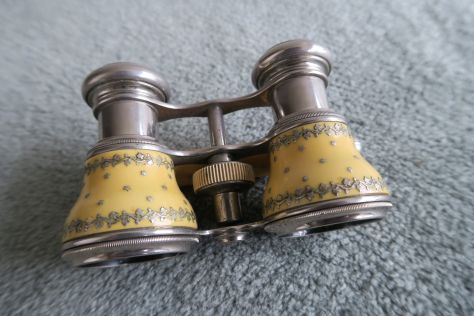My latest budget win at the local auction-house, and addition to my collection of antique optical equipment. It was different and low-priced enough that I decided it to be worth the risk to bid, and I’m very glad I did!

So what are they?
They’re a pair of Victorian/Edwardian-era opera glasses, of a style common between about 1860-1920. They would be made of brass, which was then plated heavily in nickel, and then polished to a shine. They were then coated in a light, custard-yellow resin, and the nickel stars and bands of ivy-leaves would’ve been inlaid into it.

The glasses are a style known as ‘lorgnette‘ glasses (pronounced ‘lorn-yette’), and come from the French word ‘lorgner‘ (‘to leer’ or ‘to ogle’). They come with a folding, double-extending handle, mounted on the right side of the frame, secured by a screw. Some of the star-and-ivy decorations on the handle are missing, but given that they’re 100+ years old, and on the most-touched part of the opera-glasses, that’s hardly surprising!
Who Made These Glasses?
In most cases, antique opera glasses are a real puzzle. It can be almost impossible to date them because they were made for such a long time, and styles barely changed. Fortunately, I know who made these glasses, and therefore, I can date them fairly well.

The eyepieces are labelled with the manufacturer’s mark:
“STEWART DAWSON & CO” / “LONDON & PERTH”
With this information, I was able to track down the manufacturer and retailer.
Stewart Dawson is Mr. David Stewart Dawson, born in Aberdeenshire, in Scotland, in 1849. After making a success of his trade as a watchmaker in Liverpool (where he established his first company in 1871, at the tender young age of twenty-two!), he migrated to Australia in 1886, where he settled in Sydney. Expanding on his craft, Mr. Dawson became a manufacturing jeweler, as well as an importer and retailer of luxury products, such as watches, rings, jewelry, silverware, carriage-clocks, and opera-glasses (popular gifts and accessories in the late-Victorian era).

Mr. Dawson became extremely, extremely wealthy. By the time he died, he had branches of his jewelry shops in Melbourne, Sydney, Perth, Auckland, Wellington, Dunedin, and even London! He also had several grand houses located in Sydney, New Zealand, England, and even in the Principality of Monaco (specifically in Monte Carlo!).

Dawson was a staunch supporter of the Allied war-effort in the 1910s, and also a shrewd businessman. By the time he died in August of 1932, at the age of approximately 83, he would’ve been one of the wealthiest men in Australia! Little wonder, if he made beauties like this!

The S. Dawson & Co’s shop in Wellington, NZ. This building is still standing today.
How Old Are these Opera Glasses?
Unfortunately, opera-glasses are very difficult to date with precision. Given the events of Mr. Dawson’s life, I’d say they were made between 1890-1910, which would make them late-Victorian or Edwardian. The material on the surface doesn’t look like celluloid, and the floral embellishments with the ivy-leaves suggests a nod to Art Nouveau, which would’ve been en vogue during the 1890s and the first decade of the 20th century. 1900, give or take a handful of years, is likely when they were made.